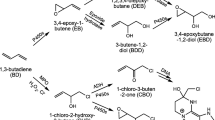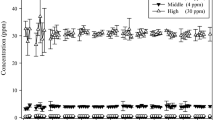Abstract
Styrene oxide (SO), a labile metabolite of styrene, is generally accepted as being responsible for any genotoxicity associated with styrene. To better define the hazard associated with styrene, the activity of the enzymes involved in the formation (monooxygenase) and destruction of SO (epoxide hydrolase and glutathione-S-transferase) were measured in the liver and lungs from naive and styrene-exposed male Sprague-Dawley rats and B6C3F1 mice (three daily 6-h inhalation exposures at up to 600 ppm styrene) and Fischer 344 rats (four daily 6-h inhalation exposures at up to 1000 ppm styrene), and in samples of human liver tissue. Additionally, the time course of styrene and SO in the blood was measured following oral administration of 500 mg styrene/kg body weight to naive Fischer rats and rats previously exposed to 1000 ppm styrene. The affinity of hepatic monooxygenase for styrene, as measured by the Michaelis constant (K m), was similar in the rat, mouse, and human. Based on theV max for monooxygenase activity and the relative liver and body size, the mouse had the greatest capacity and humans the lowest capacity to form SO from styrene. In contrast, human epoxide hydrolase had a greater affinity (i. e., lowerK m) for SO than epoxide hydrolase from rats or mice while the apparent Vmax for epoxide hydrolase was similar in the rat, mouse, and human liver. However, the activity of epoxide hydrolase relative to monooxygenase activity was much greater in the human than in the rodent liver. Hepatic glutathione-S-transferase activity, as indicated by theV max, was 6- to 33-fold higher than epoxide hydrolase activity. However, the significance of the high glutathione-S-transferase activity is unknown because hydrolysis, rather than conjugation, is the primary pathway for SO detoxification in vivo. Human hepatic glutathione-S-transferase activity was extremely variable between individual human livers and much lower than in rat or mouse liver. Prior exposure to styrene had no effect on monooxygenase activity or on blood styrene levels in rats given a large oral dose of styrene. In contrast, prior exposure to styrene increased hepatic epoxide hydrolase activity 1.6-fold and resulted in lower (0.1>P>0.05) blood SO levels in rats given a large oral dose of styrene. Qualitatively, these data indicate that the mouse has the greatest capacity and the human the lowest capacity to form SO. In addition, human liver should be more effective than rodent liver in hydrolyzing low levels of SO. Quantitative evaluation of the species differences in enzyme levels are being evaluated with the development of a physiologically based pharmacokinetic model for styrene that includes SO.
Similar content being viewed by others
References
Andersen ME (1987) Tissue dosimetry in risk assessment, or what's the problem here anyway. In: Pharmacokinetics in risk assessment, drinking water and health, vol. 8. National Academy, Washington, pp 8–23
Andersen ME, Gargas ML, Ramsey JC (1984) Inhalation pharmacokinetics: evaluating systemic extraction, total in vivo metabolism, and the time-course of enzyme induction for inhaled styrene in rats based on arterial blood: inhaled air concentration ratios. Toxicol Appl Pharmacol 73: 176–187
Barale R (1991) The genetic toxicology of styrene and styrene oxide. Mutat Res 257: 107–126
Bard Y (1974) Nonlinear parameter estimation. Academic, Orlando
Beaune P, Kremers PG, Kaminsky LW, DeGraeve J, Guengerich FP (1986) Comparison of monooxygenase activities and cytochrome P-450 isozyme concentrations in human liver microsomes. Drug Metab Dispos 14: 437–442
Belvedere G, Pachecka J, Cantoni L, Mussini E, Salmona M (1976) A specific gas Chromatographic method for the determination of microsomal styrene monooxygenase and styrene epoxide hydratase activities. J Chromatogr 118: 387–393
Belvedere G, Cantoni L, Facchinetti T, Salmona M (1977) Kinetic behavior of microsomal styrene monooxygenase and styrene epoxide hydratase in different animal species. Experentia 33: 708–709
Bocker RH, Guengerich FP (1986) Oxidation of 4-aryl- and 4-alkyl-substituted 2,6-dimethyl-3,5-bis(alkoxycarbonyl)-1,4-dihydropyridines by human liver microsomes and immunochemical evidence for the involvement of a form of cytochrome P-450. J Med Chem 29: 1596–1603
Bond JA (1989) Review of the toxicology of styrene. Critical Rev Toxicol 19: 227–249
Cantoni L, Salmona M, Facchinetti T, Pantarotto C, Belvedere G (1978) Hepatic and extrahepatic formation and hydration of styrene oxide in vitro in animals of different species and sex. Toxicol Lett 2: 179–186
Caulcutt R, Boddy R (1983) Statistics for analytical chemists. Chapman and Hall, New York
Corley RA, Mendrala AL, Smith FA, Staats DA, Gargas ML, Conolly RB, Andersen ME, Reitz RH (1990) Development of a physiologically-based pharmacokinetic model for chloroform. Toxicol Appl Pharmacol 103: 512–527
Das M, Dixit R, Mushtaq M, Srivastava SP, Seth PK (1981) Effects of styrene on mixed-function oxidase enzymes, glutathione content and glutathione-S-transferase activity in rats. Drug Chem Toxicol 4: 219–227
Ehrenberg L, Hiesche KD, Osterman-Golkar S, Wennberg I (1974) Evaluation of genetic risks of alkylating agents: tissue doses in the mouse from air contaminated with ethylene oxide. Mutat Res 24, 83–103
Elovaara E, Vainio H, Aitio A (1990) Pulmonary toxicity of inhaled styrene in acetone-, phenobarbital- and 3-methylcholanthrene-treated rats. Arch Toxicol 64: 365–369
Gibaldi M, Perrier D (1975) Pharmacokinetics. Dekker, New York
Guengerich FP (1977) Studies on the activation of a model furan compound -Toxicity and covalent binding of 2-(N-ethylcarbamoylhydroxymethyl) furan. Biochem Pharmacol 26: 1901–1915
Guengerich FP, Martin MV, Beaune PH, Kremers P, Wolff T, Waxman DJ (1986 a). Characterization of rat and human liver microsomal cytochrome P-450 forms involved in nifedipine oxidation, a prototype for genetic polymorphism in oxidative drug metabolism. J Biol Chem 261: 5051–5060
Guengerich FP, Muller-Enoch D, Blair IA (1986 b). Oxidation of quinidine by human liver cytochrome P-450. Mol Pharmacol 30: 287–295
Hall SD, Guengerich FP, Branch RA, Wilkinson GR (1987) Characterization and inhibition of mephenytoin 4-hydroxylase in human liver cytochrome P-450. J Pharmacol Exp Ther 240: 216–222
Harms PG, Ojeda SR (1974) A rapid and simple procedure for chronic cannulation of the rat jugular vein. J Appl Physiol 36: 391–392
Ivanetich KM, Goold RD, Sikakana CNT (1990) Explanation of the non-hyperbolic kinetics of the glutathione S-transferase by the simplest steady-state random sequential Bi Bi mechanism. Biochem Pharmacol 39: 1999–2004
Jersey GC, Balmer MF, Quast JF, Park CN, Schuetz DJ, Beyer JE, Olson KJ, McCollister SB, Rampy LW (1978) Two year chronic inhalation toxicity and carcinogenicity study on monomeric styrene in rats. Manufacturing Chemists Association, MCA No. S74 1.1-Tox-INH, Dow Chemical Co., Midland, MI, USA
Johnson MK (1966) Studies on glutathione S-alkyltransferase of the rat. Biochem J 93: 44–55
Kapitulnik J, Levin W, Lu AYH, Morecki R, Dansette PM, Jerina DM, Conney AH (1977) Hydration of arene and alkene oxides by epoxide hydrase in human liver microsomes. Clin Pharmac Ther 21: 158–165
Knodell RG, Hall SD, Winkingon GR, Guengerich FP (1987) Hepatic metabolism of tolbutamide: In vivo characterization of the form of cytochrome P-450 involved in methyl hydroxylation and relationship to in vivo disposition. J Pharmacol Exp Ther 241: 1112–1119
Langvardt PW, Nolan RJ (1991) Determination of styrene-7,8-oxide in whole rat blood by gas chromatography-mass spectrometry. J Chromatogr 567: 93–103
Lowry OH, Rosebrough NJ, Farr AL, Randall RJ (1951) Protein measurement with the Folin phenol reagent. J Biol Chem 193: 265–275
Miller RR, Letts RL, Potts WJ, McKenna MJ (1980) Improved methodology for generating controlled test atmospheres. Am Ind Hyg Assoc J 4: 844–846
Oesch F (1973) Mammalian epoxide hydrases: inducible enzymes catalysing the inactivation of carcinogenic and cytotoxic metabolites derived from aromatic and olefinic compounds. Xenobiotica 3: 305–340
Oesch F, Daly J (1971) Solubilization, purification, and properties of hepatic epoxide hydrase. Biochim Biophys Acta 227: 692–697
Oesch F, Jerina DM, Daly J (1971) A radiometric assay for hepatic epoxide hydrase activity with [7-3H] styrene oxide. Biochim Biophys Acta 227: 685
Pacifici GM, Boobis AR, Brodie MJ, Davies DS (1979) A rapid sensitive assay for glutathione S-transferase activity: species differences in the activity of the hepatic enzyme. Biochem Soc Trans 7: 1060–1061
Pacifici GM, Boobis AR, Brodie MJ, McManus ME, Davies DS (1981) Tissue and species differences in enzymes of epoxide metabolism. Xenobiotica 11: 73–79
Pacifici GM, Warholm M, Guthenberg C, Mannervik B, Rane A (1987) Detoxification of styrene oxide by human liver glutathione tansferase. Human Toxicol 6: 483–489
Pacifici GM, Franchi M, Bencini C, Repetti F, Di Lascio N, Muraro GB (1988) Tissue distribution of drug-metabolizing enzymes in humans. Xenobiotica 18: 849–956
Pantarotto CM, Salmona M, Szczawinska K, Bidoli F (1980) Gas Chromatographic — mass spectrometric studies on styrene toxicity. ISS Anal Tech Environ Chem 3: 245–279
Parkki MG, Marniemi J, Vainio H (1976) Action of styrene and its metabolites styrene oxide and styrene glycol on activities of xenobiotic biotransformation enzymes in rat liver in vivo. Toxicol Appl Pharmacol 38: 59–70
Ramsey JC, Andersen ME (1984) A physiological based description of the inhalation pharmacokinetics of styrene in rats and humans. Toxicol Appl Pharmacol 73: 159–175
Reitz RH, Mendrala AL, Guengerich FP (1989) In vitro metabolism of methylene chloride in human and animal tissues: use in physiologically based pharmacokinetic models. Toxicol Appl Pharmacol 97: 230–246
Ryan AJ, Bend JR (1977) The metabolism of styrene oxide in the isolated perfused rat liver. Drug Metab Disp 5: 363–367
Salmona M, Pachecka J, Cantoni L, Belvedere G, Mussini E, Garattini S (1976) Microsomal styrene mono-oxygenase and styrene epoxide hydrase in rats. Xenobiotica 6: 585–591
Van Anda J, Smith BR, Fouts JR, Bend JR (1979) Concentration-dependent metabolism and toxicity of [14C] styrene oxide in the isolated perfused rat liver. J Pharmacol Exp Ther 211: 207–212
Von Bahr C, Groth CG, Jansson H, Lundgren G, Lind M, Glaumann H (1980) Drug metabolism in human liver in vitro: establishment of a human liver bank. Clin Pharmacol Ther 27: 711–725
Author information
Authors and Affiliations
Rights and permissions
About this article
Cite this article
Mendrala, A.L., Langvardt, P.W., Nitschke, K.D. et al. In vitro kinetics of styrene and styrene oxide metabolism in rat, mouse, and human. Arch Toxicol 67, 18–27 (1993). https://doi.org/10.1007/BF02072030
Received:
Accepted:
Issue Date:
DOI: https://doi.org/10.1007/BF02072030




